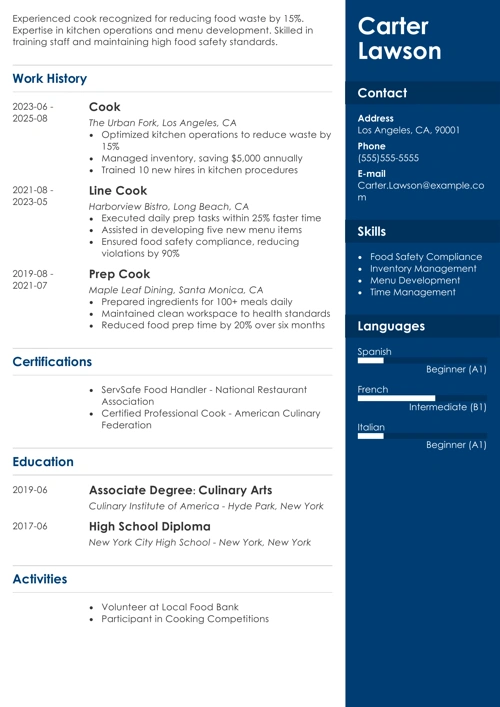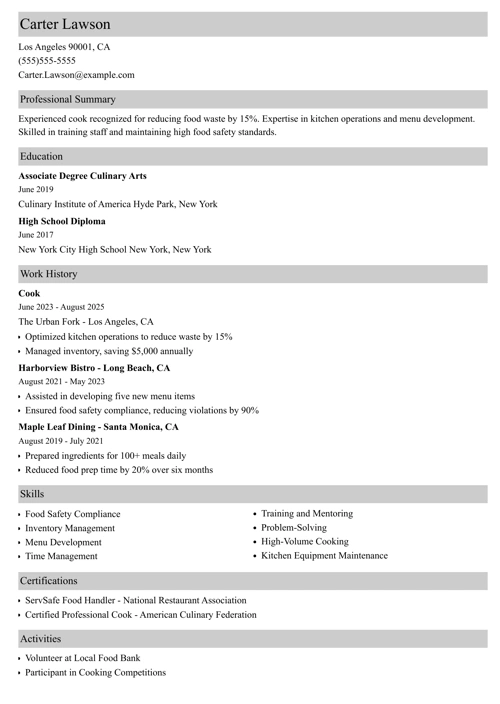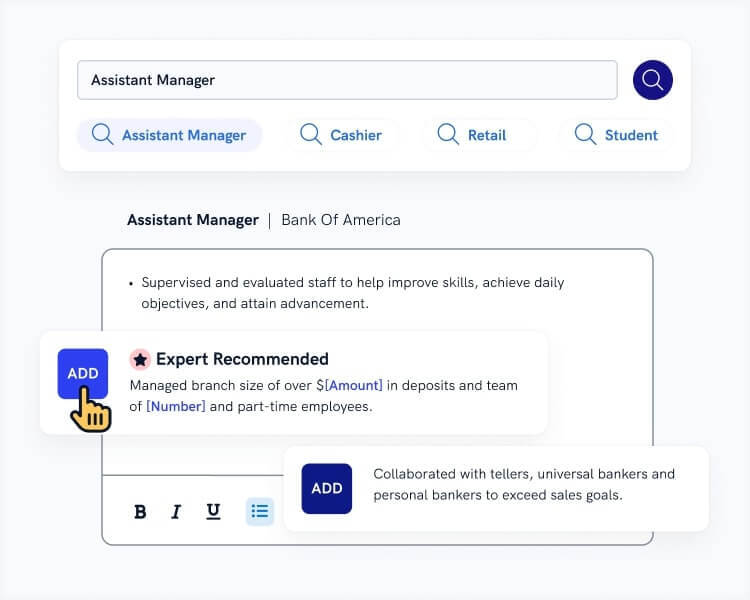Are you ready to spice up your career as a cook? Crafting a standout cook resume is your ticket to landing that dream job in the culinary world. In this article, you'll discover expert tips and cook resume examples that will help you showcase your culinary skills and experiences, making you the top choice for employers.
This guide will show you:
- A cook resume example that’s better than 9 out of 10 other resumes.
- How to write a cook resume that will land you more interviews.
- Tips and examples of how to put skills and achievements on a cook resume.
- How to describe your experience on a resume for a cook to get any job you want.
Want to save time and have your resume ready in 5 minutes? Try our resume builder. It’s fast and easy to use. Plus, you’ll get ready-made content to add with one click. See 20+ resume templates and create your resume here.
Sample resume made with our builder—See more resume examples here.
One of our users, Brittanya, had this to say:
Zety really helped me create the best resume possible. It pointed out how things could be better on my existing resume and suggested many things to be re-worded or removed.
Want to check more samples related to cook? Here you go:
- Line Cook Resume Examples
- Culinary Resume Examples
- Chef Resume Examples
- Sous Chef Resume Examples
- Catering Resume Examples
- Restaurant Resume Examples
- Banquet Server Resume Examples
- Food Service Resume Examples
- McDonald’s Resume Examples
- Best Resume Examples for All Jobs
Cook Resume Sample
Carter Lawson
Cook
1-405-738-5623
carterlawson@email.com
linkedin.com/in/carterlawson
Summary
Diligent cook with 6+ years of culinary experience, known for improving kitchen workflows and maintaining high standards in fast-paced environments. Proven record in reducing food costs by 10% through efficient inventory management and enhancing customer satisfaction by introducing menu items with a 4.8-star rating. Skilled in collaboration, quality control, and multitasking in high-pressure settings. Looking to bring strong organizational skills and a passion for culinary excellence to a dynamic kitchen team.
Experience
Sous Chef
Greenwich Bistro, Tulsa, OK
February 2022–Present
- Oversaw the daily operations of a team of 12 kitchen staff, ensuring dishes were prepared to the highest standard.
- Created seasonal menu items that increased customer satisfaction ratings from 4.5 to 4.8.
- Collaborated with the chef to design and introduce a weekly “Chef's Special,” which contributed to a 15% rise in weekly patron attendance.
- Led food waste reduction efforts, achieving a 10% monthly decrease in disposal costs.
- Key achievement: Received "Best New Dish" recognition in Tulsa Cuisine Weekly for a signature entrée created for the bistro.
Line Cook
Tasteful Grills, Norman, OK
March 2019–January 2022
- Prepared dishes while adhering to strict restaurant quality standards, reducing order wait times by 20% during peak hours.
- Conducted on-the-job training for 15 new hires, focusing on hygiene standards and effective kitchen workflows.
- Monitored inventory weekly, maintaining ingredient availability with zero shortages over a six-month period.
- Collaborated with a local farm to source organic produce, resulting in a 5% monthly reduction in ingredient costs.
- Key achievement: Boosted order accuracy to 98%, enhancing customer satisfaction.
Education
Associate of Culinary Arts
University of Central Oklahoma, Edmond, OK
August 2016 – May 2018
Relevant Coursework:
- Food Service Management
- Nutrition and Menu Planning
Skills
- Advanced cooking techniques
- Menu planning
- Inventory management
- Quality control
- Safety and sanitation compliance
- Adaptability
- Effective communication
- Team leadership
- Multitasking under pressure
- Time management
Publications
- “Reducing Waste in the Kitchen: Strategies for Small Restaurants,” Oklahoma Food Journal, May 2022
- “Organic Sourcing and Its Impact on Flavor,” Chefs United Magazine, December 2021
Certificates
- Food Safety and Sanitation Certificate, National Restaurant Association, February 2019
- Certified Sous Chef (CSC), American Culinary Federation, April 2021
Hobbies
- Food blogging
- Exploring local farmers' markets
- Recipe development
Here’s how to write your own cook resume:
1. Format Your Cook Resume Correctly
Your cook resume needs to make a striking first impression amidst a table full of tasty applications. The secret recipe? A well-structured resume format that appears polished and professional can catch the attention of hiring managers.
Here’s how to format a resume for cook positions:
- Begin with a clear resume header. Include your name, phone number, email address, LinkedIn profile, and any relevant online portfolio. These are essential contact details for a resume.
- Choose a reverse-chronological resume, listing your most recent job first. This is the preferred resume layout as it aligns with employer expectations.
- Select a professional font for a resume, such as Arial, Calibri or Times New Roman. Set its optimal size for 10 to 12 points.
- Save your resume file as a PDF file to keep the formatting intact.
- Name your resume like this: “Your Name—Cook—Resume.pdf” to leave little place for any misunderstanding.
- Stick to the correct resume length. For most cooks, a one-page resume suffices, but if you have extensive achievements, consider extending it to a two-page resume or more.
Pro Tip: If you have more skills than experience, use a skill-based resume format instead of a chronological one. If you feel you should combine skills with experience, select a combination resume format.
2. Customize Your Cook Job Description
there are currently 2.18 million cooks in the USA. Nearly 441,400 openings for cooks are projected each year. You must make a great first impression. Let’s start with your work experience section that will help you tailor your resume to the job offer.
Here’s how to add relevant experience to your resume:
- Use the exact job title mentioned in the job ad. ATS resumes function best with precise business position titles.
- Add up to 6 resume bullet points, focusing more on recent roles.
- Demonstrate how you applied key job skills through achievements. Highlight accomplishments on your resume using metrics and KPIs.
- Begin sentences with resume action verbs such as coordinated, designed, and prepared.
Cook Responsibilities for a Resume - Example
- Prepare and cook various dishes, ensuring high quality and presentation standards.
- Assist in menu planning and development, incorporating seasonal ingredients and customer preferences.
- Maintain cleanliness and organization of the kitchen, adhering to health and safety regulations.
- Collaborate with kitchen staff to streamline food preparation processes and improve efficiency.
- Monitor inventory levels, order supplies, and manage food costs to minimize waste.
- Train and supervise junior kitchen staff, fostering a productive and positive work environment.
- Adapt recipes to accommodate dietary restrictions and customer requests.
Remember to use action verbs that convey your responsibilities and achievements effectively. Here are some action verbs for the cook:
Cook Resume Action Verbs - Example
- Prepared
- Cooked
- Assisted
- Collaborated
- Monitored
- Trained
- Managed
- Adapted
- Executed
- Developed
Read more: How to Show Freelance Work on a Resume
3. Make Your Education Section Count
Many job seekers include their educational background on a resume, but simply listing your degree, school, and graduation date misses the opportunity to stand out. To enhance your resume, demonstrate how your education has equipped you with additional skills and competencies that are relevant to the culinary field.
Here’s how to do it right:
- Place your education section strategically, ideally after your work experience.
- Include the following information:
- Your Degree
- Minors and Majors
- City and State of Your School
- Date of Graduation (unless you’re still studying, then include your date of expected graduation)
- Consider adding the following information:
- Relevant Courses
- Extracurricular Activities
- Impressive GPA (that’s 3.5 or higher)
- Studying Abroad
Pro Tip: Including your high GPA can be beneficial if it's equal to or higher than 3.5.
Making a resume with our builder is incredibly simple. Follow our step-by-step guide, use ready-made content tailored to your job and have a resume ready in minutes.
When you’re done, Zety’s resume builder will score your resume and our resume checker will tell you exactly how to make it better.
4. Prove the Cook Skills the Company Wants
Identifying the skills on a resume is essential, but it’s important to approach this strategically. Instead of randomly selecting skills, focus on those that the job posting highlights as crucial.
Here's how to effectively add cook skills to your resume:
- Incorporate the skills listed in the job ad as resume keywords. Include them in your skills section.
- Avoid overwhelming your resume with too many skills. Stick to the most relevant ones to ensure they stand out.
- Increase your chances of being called for an interview, by ensuring the skills you list are also reflected in your job and education bullet points.
Here are some hard skills and some soft skills for a cook resume:
Cook Resume Skills
- Food preparation
- Menu development
- Inventory management
- Culinary techniques
- Kitchen safety
- Team collaboration
- Time management
- Attention to detail
- Customer service
- Adaptability
Read more: What is the Difference Between Hard Skills and Soft Skills
5. Add Other Sections to Your Cook Resume
Hiring managers often wonder about a candidate's potential beyond their listed qualifications. They want to know if you can take charge and contribute effectively. Including additional sections in your resume can demonstrate your initiative and enthusiasm.
Here are a few ways to showcase your strengths:
- Highlight any certifications and licenses that bolster your culinary expertise, such as food safety or specialized cooking techniques.
- Include your publications on a resume to underscore your passion and authority in the cooking field.
- Mention any membership in professional culinary associations to signal your commitment and involvement in the industry.
- Add participation in volunteer work related to cooking to emphasize your dedication and skill set.
- Show your language skills, as they can be a valuable asset, especially in diverse culinary environments.
Read more: How to List Hobbies on a Resume
6. Write a Cook Resume Summary or Resume Objective
Instead of assuming that the hiring manager will read every detail on your resume, capture their attention immediately with a concise introduction. This quick summary should highlight the most important aspects of your professional background and goals.
We refer to this as a resume profile. While some might call it an elevator pitch, remember that it's a brief snapshot meant to pique interest within a few seconds. If you have relevant experience, mention your job title, how you can benefit the company, and a few standout achievements. This is known as a professional summary and should be placed at the top.
If you're crafting a resume with no work experience, focus on accomplishments from academic or personal projects, which we refer to as resume objectives.
Read more: What Makes Your Resume Unique
7. Write a Cover Letter for Your Cook Resume
In today's competitive job market, cover letters are more important than ever. They show that you're genuinely interested in the specific position and company. A well-crafted cover letter can set you apart from other applicants who send generic resumes.
To create an effective cover letter:
- Start with a professional structure that matches your resume, including a formal signoff.
- Keep your cover letter format concise, to 3–5 paragraphs and under a page.
- Begin your cover letter with the job title and an engaging hook.
- In the body, highlight key achievements that align with the job requirements.
- Conclude your letter by summarizing your skills and expressing a desire to discuss how you can contribute.
- Follow up with a brief email weekly for a month, attaching your resume and cover letter.
Don’t miss a thing. Read our guide: Parts of a Cover Letter
Plus, a great cover letter that matches your resume will give you an advantage over other candidates. You can write it in our cover letter builder here. Here's what it may look like:
See more cover letter templates and start writing.
Remember, your cook resume is your first opportunity to impress potential employers, so make it count!
About Zety’s Editorial Process
This article has been reviewed by our editorial team to make sure it follows Zety's editorial guidelines. We’re committed to sharing our expertise and giving you trustworthy career advice tailored to your needs. High-quality content is what brings over 40 million readers to our site every year. But we don't stop there. Our team conducts original research to understand the job market better, and we pride ourselves on being quoted by top universities and prime media outlets from around the world.




